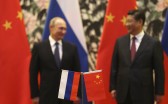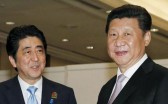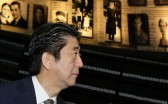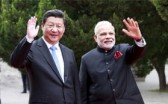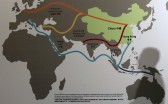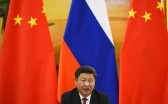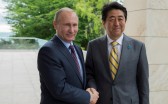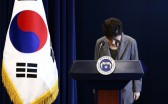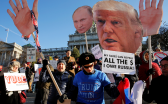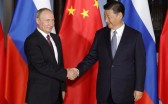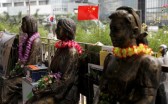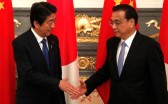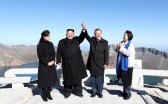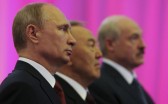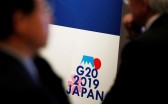In recent weeks there has been a palpable shift in the tenor of China-Japan relations. On November 1, Premier Li Keqiang and Prime Minister Abe Shinzo met in Seoul as part of the China-Japan-Korea (CJK) trilateral summit—the first to be held since 2012 because of history and security disputes between Japan and China and history disputes between Japan and Korea. Chinese media coverage was carefully coordinated to support the summit’s key message: trilateral cooperation has been “completely restored.” Leading up to and in the wake of the summit, Xinhua quoted numerous Chinese officials, academic experts, and analysts at think tanks, who each emphasized that the three countries were entering a new, more cooperative phase in their relationship. Secretary-general of the Trilateral Cooperation Secretariat, Yang Houlan, stated, “cooperation among the three countries is finding its way out of the straits, returning to the right track and marching into a new phase.” Similarly, vice-minister of foreign affairs Liu Zhenmin underscored the importance of trilateral cooperation in “maintaining regional peace and stability, and powering the economic development of Asia and the world.” Though more cautious, Ruan Zongze, vice president of the China Institute of International Studies, also emphasized that China, Japan, and South Korea “are intent on improving relations and handling differences.” In line with this, official statements and media commentary have begun to re-emphasize the importance of three-way practical cooperation on issues such as economic interdependence, humanitarian assistance, and safe development of nuclear energy.
This positive coverage of the trilateral summit followed in the wake of extensive and positive media coverage of the Beijing-Tokyo Forum, an event organized in Beijing in late October by the China Daily media group and the Japanese non-profit organization, Genron NPO. The forum brought together 500 Chinese and Japanese officials, former officials, academics, and members of the business community. High profile newspaper and television coverage signified the government’s view of the importance of the relationship, and the need to improve bilateral ties. These views were, perhaps, most clearly expressed by Fu Ying, a senior diplomat and the current chair of the Foreign Affairs Committee within the National People’s Congress, who emphasized that China and Japan were the two largest economies in Asia, and that tensions between the two countries were harming not only China and Japan, but also the wider Asia-Pacific region. It was time, she said, for the two to cooperate to overcome their tensions and assist the region in regaining its economic momentum.
This more positive official language on the China-Japan relationship contrasts sharply with the tenor of bilateral relations since the Japanese government purchased three islands in the Diaoyu/Senkaku island chain in September 2012. The two countries descended into an unhealthy spiral of diplomatic name-calling, dangerous brinksmanship in the East China Sea, and competition over which country was doing more to undermine Asia’s postwar order. Since late 2014, however, they have attempted to repair some of these tensions. The Beijing-Tokyo Forum and trilateral summit represent the two most recent examples.
In Part I of “Scenario of China’s Fault,” I explored some underlying strategic reasons why this current period of easing China-Japan relations is unlikely to endure. In Part II, I turn to the domestic level and consider how the Chinese public might respond to this recent upturn in relations. To do so, it is instructive to first look back at a previous instance of conflict, cooperation, and renewed conflict in the China-Japan relationship.
Between 2001 and 2005, the China-Japan relationship experienced significant strain stemming from energy and maritime disputes in the East China Sea, visits to the Yasukuni Shrine by Prime Minister Koizumi Junichiro, disputes over the content of Japanese history textbooks, and Japan’s bid for a permanent seat on the UN Security Council. This five-year period of antagonism culminated in violent anti-Japanese protests in cities across China in March and April 2005. The following year, the two countries used the opportunity of a change in Japanese leadership to improve the tenor of bilateral relations. Weeks after coming to power in September 2006, Abe travelled to China for what he referred to as an “ice-breaking” visit. In 2007, Premier Wen Jiabao returned the favor with his own “ice-melting” visit to Japan. These visits sought to reset the official tone of the bilateral relationship.
However, this official shift in rhetoric was not sufficient to thaw widespread anti-Japanese sentiment within the Chinese population. Despite Beijing and Tokyo’s efforts to put relations on a more positive trajectory, public opinion in China was not willing to follow along. One of the issues most troubling the relationship in 2006 was the maritime boundary in the East China Sea. Problems had arisen in 2003 when state-owned China National Offshore Oil Corporation (CNOOC) entered into an agreement with foreign companies to begin producing natural gas in fields located close to Japan’s claimed median line. After years of diplomatic negotiations, in 2008, the two sides finally reached a “principled consensus” to undertake joint development in gas fields straddling the median line. This was a major achievement. The consensus was reached only after significant concessions by Hu Jintao and the Chinese Foreign Ministry to allow Japan to participate in the joint development of gas fields that straddled in this manner. However, this significant concession was too much for some in China. As research by James Manicom shows, the “principled consensus” received strident criticism from more hard-line elements of the Chinese bureaucracy and the wider Chinese population, and the joint development agreement was never implemented. In May 2010, Wen Jiabao tried to revive the joint development negotiations, but the process was disrupted in September that year when a Chinese fishing trawler captain collided with Japanese Coast Guard vessels in the East China Sea. Japan’s arrest of the Chinese trawler captain sparked a diplomatic protest by Beijing, and raised the specter of another round of violent anti-Japanese protests. The Chinese government used local law enforcement and media channels to thwart protests in major cities, but failed to prevent anti-Japanese demonstrations in second-tier cities such as Chengdu and Xian. Given public sentiment, there was little appetite within the Hu Jintao-Wen Jiabao administration to resume joint development negotiations with Japan.
These incidents raise questions about the ability of the Chinese government to exert complete control over its bilateral relationship with Japan, and about the impact of public opinion on Chinese foreign policy. The Communist Party of China (CCP) has overwhelming power to influence the way in which China’s museums, history textbooks, academic historians, and media characterize the China-Japan relationship, but it is not all-powerful. Instead, as Suzuki Shogo has shown, the renewed emphasis, since the end of the Cold War, on Japan’s history of imperialism in China is influential only because it resonates with deeply-held sentiment within the wider population. When the Party decides to change its message, as we have seen in recent weeks, it may create discord with popular sentiment. How this popular sentiment interacts with Chinese foreign policy is one of the key questions facing the China-Japan relationship.
In fact, the China-Japan relationship has served as a test case for some of the most important new research on the role of public opinion, popular protest, online nationalism, and media commercialization in China. Frequent and large-scale anti-Japanese public protests in China have prompted researchers to seek to better understand the relationship between Chinese society and the state in general, and public opinion and foreign policy in particular. For instance, the 2005 anti-Japanese protests prompted questions about whether Beijing was still fully in control of foreign policy making. Many concluded that the protests were a sign that the foreign ministry, and the government more generally, was losing its exclusive grip on foreign policy-making and that the Chinese public was pushing the government in a more nationalist direction. Others wondered—somewhat hopefully—whether the rise of popular protest was a sign of a burgeoning democratic movement in China (even if these protests suggested that a democratic China might be a more nationalistic China).
Yet, in-depth scholarly research on these and more recent rounds of anti-Japanese protests tells a quite different and, perhaps, somewhat more alarming story. Research by James Reilly compares multiple occurrences of popular anti-Japanese protests in China since the mid-1980s in order to examine the effects of public opinion on foreign policy-making. It shows that, rather than being a sign of weakening government control, the CCP has, in fact, used all of the tools at its disposal to carefully shape and control public opinion and nationalist sentiment. Reilly shows how, after initially allowing the public to “vent” their anger through demonstrations, the government then makes use of internet blocking software, media editorials, and local law enforcement as a way of curtailing or regulating public protests. This “responsive authoritarianism” allows the government to permit a certain amount of anti-Japanese venting, while simultaneously ensuring that nationalist sentiment does not spiral out of control and endanger China’s external relations or the CCP’s own hold on power. Research by Jessica Chen Weiss concurs with this finding on the government’s wave-like pattern of tolerance and repression of anti-Japanese protests, but also shows how the government has instrumentally used popular anti-Japanese sentiment as a bargaining chip in international negotiations. Examining the 2005 anti-Japanese protests—in part a response to Japan’s bid for a permanent seat on the Security Council—, Weiss shows how the protests were used by Beijing to send a signal to the United States and wider international community that China strongly opposed Japan’s bid. As Weiss explains, because it is risky for an authoritarian state to permit public demonstrations, tolerating the 2005 protests gave Beijing a way of signalling that China’s international negotiating stance was constrained by domestic public opinion. Because of anti-Japanese sentiment at home, the government argued, China had no choice but to oppose Japan’s bid. While this domestic anti-Japanese sentiment is real, and does constrain Chinese foreign policy, cases such as these are not simply signs that the government has lost control of the policy making process. Rather, as Weiss’ research on other non-Japanese cases shows, Beijing can also choose to repress public demonstrations as a way of signalling its interest in maintaining good international relations. This behavior was clearly demonstrated in 2001 when the Chinese government curtailed anti-US protests following the EP-3 spy plane collision. Prohibiting protests was a way of signalling to the George W. Bush administration that China was eager to maintain stable US-China relations.
Finally, research by Daniela Stockmann has explored the way in which China’s state-run and commercialized media affects the China-Japan relationship. Again examining the 2005 anti-Japanese protests, Stockmann shows how the Chinese Propaganda Department sought to limit the scale of the protests by banning the publication of stories about the protests and requiring newspapers to follow the government line when reporting on Japan. These restrictions applied not only to state-run newspapers but also to privately-run commercialized ones. A major finding of Stockmann’s research is that Chinese citizens view commercial newspapers as more trustworthy than state-run newspapers, even though both are subject to the same Propaganda Department controls. As a result, surveys of Chinese readers showed that the restrictions against anti-Japanese content had a greater effect on changing the views of those who read commercial newspapers than those who read state-run papers. After the media restrictions were put in place, commercial readers’ views of Japan had improved considerably more than the views of those who read state-run newspapers. Stockmann’s findings, therefore, show that in an era of increasingly commercialized-media organisations in China, the Chinese government has actually strengthened its ability to guide public opinion. By retaining the ability to restrict the media content of commercial newspapers, which are deemed more trustworthy by the Chinese public, these commercial media organizations are now selling the government’s message even more effectively than before.
Ultimately what this research shows is not a government under threat from popular nationalism, but instead a government that is growing increasingly sophisticated in its use of traditional and newer tools to shape its public message. It is still too soon to tell how the Chinese public will respond to the most recent round of official “thawing” in China-Japan relations. Yet, we can be sure that the government will be watching public opinion closely, and will be using law enforcement, state-run and commercial media, and web-blocking software to guide public opinion. At the same time, it will also be responsive to potential sparks in anti-Japanese sentiment, and domestic public opinion will influence the way in which it pursues international negotiations with Japan.

